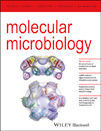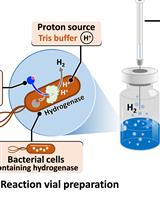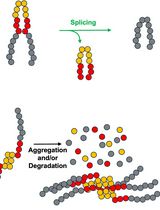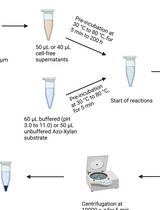- EN - English
- CN - 中文
Substituted Cysteine Accessibility Method for Topology and Activity Studies of Membrane Enzymes Forming Thioester Acyl Intermediates in Bacteria
在细菌中利用取代半胱氨酸可及性方法研究硫酯酰基中间体膜生化酶的拓扑结构和活性
发布: 2015年11月05日第5卷第21期 DOI: 10.21769/BioProtoc.1640 浏览次数: 8589
评审: Fanglian HeSoazig Le Guyon Anonymous reviewer(s)
Abstract
The topology of membrane proteins and enzymes can be determined using various methods including reporter protein fusions and accessibility of cysteine residues to alkylating agents. Here we describe a variation of the substituted cysteine accessibility method to determine membrane topology and activity of enzymes containing an active site cysteine. Membrane topology of proteins can be predicted using different programs and the actual membrane topology can be determined by monitoring the accessibility of cysteine residues introduced in periplasmic (exposed) or cytoplasmic (not exposed) loops to alkylating agents. A two-step protocol is described where whole Escherichia coli (E. coli) cells are first treated with or without a membrane impermeable thiol reagent (2-sulfonatoethyl)-methane thiosulfonate (MTSES) and subsequently labeled with an alkylating reagent maleimide polyethyleneglycol (malPEG). When cysteine residues are accessible to MTSES, and thus exposed to (or accessible from) the periplasm, their free thiol groups covalently react with MTSES and consequently, are blocked for alkylation with malPEG. The thiol groups of cytoplasmic or membrane-embedded cysteine residues are not accessible to MTSES and proteins can be alkylated with malPEG resulting in an increase in molecular weight of 5 kDa. In the second part of the protocol, accessibility of cysteine residues is used to address the acylation state of enzymes that form stable thioester acyl intermediates. Thioesters can be specifically cleaved by neutral hydroxylamine, leading to a free thiol group of the active site cysteine that can then be alkylated with malPEG.
Materials and Reagents
- Escherichia coli K12 cells
- Distilled sterile water (dH2O)
- Acetone (Sigma-Aldrich, catalog number: 24201-1L-R )
- Chloroform (CHCl3) (VWR International, catalog number: 22711.290 )
- Trichloroacetic acid (TCA) (Sigma-Aldrich, catalog number: 27242-500G-R )
- Ethanol (EtOH) (100%) (Sigma-Aldrich, catalog number: 24103-5L-R )
Note: Product 24103 has been discontinued. - Tris(hydroxymethyl)aminomethane hydrochloride (Trizma base) (Sigma-Aldrich, catalog number: 337411KG )
- 1 M KH2PO4 (Merck Millipore Corporation, catalog number: A148973 )
- 1 M Potassium phosphate dibasic K2HPO4 (Fluka, catalog number: 60353 )
Note: Currently, it is “ Sigma-Aldrich, catalog number: 60353 ”. - Sodium dodecyl sulfate 20%SDS 20% (biosolve-chemicals, catalog number: 19812323 )
- Urea (Merck Millipore Corporation, Calbiochem®, catalog number: 66612 )
- NaOH (Merck Millipore Corporation, catalog number: 21778425 )
- Bromophenol blue (Sigma-Aldrich, catalog number: 114391 )
- Glycerol (VWR International, catalog number: 24388.295 )
- Parafilm (Thomas Scientific, Pichiney Plastic Packaging, catalog number: PM-992 )
- 50 mM Phosphate buffer (PB) (pH 7.0) (see Recipes)
- 250 mM Ethylenediaminetetraacetic acid (EDTA) (Sigma-Aldrich,catalog number: ED2SS ) (see Recipes)
- 0.3 M Sodium (2-sulfonatoethyl) methane thiosulfonate (MTSES) (Anatrace, catalog number: S110MT ) (see Recipes)
- 1 M L-cysteine (IGN, catalog number: 194646 ) (see Recipes)
Note: Currently, it is “mpbio, catalog number: 194646 ”. - Methanol (MeOH) (95%) (Sigma-Aldrich, catalog number: 32213-1L ) (see Recipes)
- 1 M Tris-HCl (see Recipes)
- Denaturation buffer (see Recipes)
- PEG buffer (see Recipes)
- 1.2 mM Methoxypolyethylene glycol 5000 maleimide (malPEG) (Sigma-Aldrich, catalog number: 63187 ) (see Recipes)
- Hydroxylamine solution (HA) (Sigma-Aldrich, catalog number: 59417 ) (see Recipes)
- 1 M Tris.HCl, 1% SDS (see Recipes)
- SDS-Sample buffer (see Recipes)
- DL-Dithiothreitol (DTT) (Sigma-Aldrich, catalog number: D9779 ) (see Recipes)
Equipment
- Incubator (37 °C) (Infors AG)
- Spectrophotometer (600 nm) (Eppendorf, model: Biophotometer plus )
- Tabletop centrifuge (Eppendorf, model: 5472R/5427R )
- Gelectrophoresis apparatus (Bio-Rad Laboratories, model: Miniprotean II )
- Western blot apparatus (Bio-Rad Laboratories, model: Transblot Turbo )
- Vortex Genie 2 (Scientific Industries)
Procedure
文章信息
版权信息
© 2015 The Authors; exclusive licensee Bio-protocol LLC.
如何引用
Gélis-Jeanvoine, S. and Buddelmeijer, N. (2015). Substituted Cysteine Accessibility Method for Topology and Activity Studies of Membrane Enzymes Forming Thioester Acyl Intermediates in Bacteria. Bio-protocol 5(21): e1640. DOI: 10.21769/BioProtoc.1640.
分类
微生物学 > 微生物生物化学 > 蛋白质 > 结构
微生物学 > 微生物生物化学 > 蛋白质 > 活性
生物化学 > 蛋白质 > 结构
您对这篇实验方法有问题吗?
在此处发布您的问题,我们将邀请本文作者来回答。同时,我们会将您的问题发布到Bio-protocol Exchange,以便寻求社区成员的帮助。
提问指南
+ 问题描述
写下详细的问题描述,包括所有有助于他人回答您问题的信息(例如实验过程、条件和相关图像等)。
Share
Bluesky
X
Copy link












